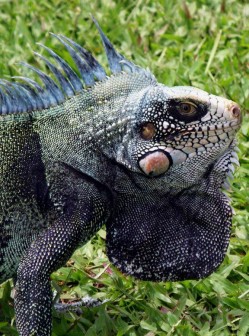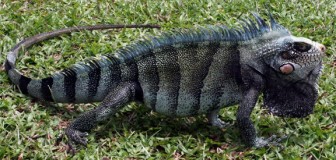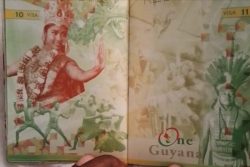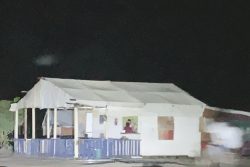The Common Iguana (Iguana iguana) or ‘Guana,’ is a large green lizard that grows up to 1.8 m, with a cylindrical body and a high spiky crest of scales running the length of the spine. Iguanas have a large gular fan (dewlap) and a flat round scale below the ear opening that is actually the tympanum of the ear. They inhabit all kinds of forests and are arboreal. If you have sharp eyes you can often spot them basking on high branches in trees as you travel along rivers in the Iwokrama Forest or Rupununi Savannah; their green scaly armour is a perfect camouflage in the surrounding foliage. More often they can be seen and heard dropping into the water from their tree perch in alarm over the river as you pass. They are excellent swimmers and are comfortable in the water.
In the Rupununi, Iguanas lay their eggs in the dry season on exposed sandbanks along the rivers. Mating occurs early in the season while the eggs are laid later to ensure hatching at the start of the rains when food is plentiful.
![]() Their eggs and meat are food resources for predators such as salipenter (Tegu lizard), hawks, vultures, and humans. In some countries Guana are farmed as a source of food, for their skin and for the pet trade. They are a pest in farming areas as they are vegetarians and can raze the leaves of crops overnight. Ecologically Iguanas help in the dispersal of seeds and can be an indicator of environmental change.
Their eggs and meat are food resources for predators such as salipenter (Tegu lizard), hawks, vultures, and humans. In some countries Guana are farmed as a source of food, for their skin and for the pet trade. They are a pest in farming areas as they are vegetarians and can raze the leaves of crops overnight. Ecologically Iguanas help in the dispersal of seeds and can be an indicator of environmental change.
 Iguanas are listed as an Appendix II species by the Convention of International Trade of Endangered Species and as such importers and exporters must have a valid export permit for trading this species. They are listed as “threatened” by the International Union for the Conservation of Nature (IUCN).
Iguanas are listed as an Appendix II species by the Convention of International Trade of Endangered Species and as such importers and exporters must have a valid export permit for trading this species. They are listed as “threatened” by the International Union for the Conservation of Nature (IUCN).
Rain forests are rich in biodiversity and are home to many different plants and animals as well as indigenous communities. Humans, even those who don’t live in the rain forest, rely on it for resources such as building materials (wood and lianas), medicine and fruits. Rain forests also provide essential environmental services for life on earth; they create soil as well as prevent soil erosion, produce oxygen though photosynthesis, maintain clean water systems, and are a key defence against climate change.
The Iwokrama Rain Forest is 371,000 hectares, located in the heart of

Guyana. Our mission is to develop strategies for conservation and sustainable development for local people in Guyana and the world at large. We are involved in timber, tourism and training. Come and visit us in the rain forest or at http://www.iwokrama.org.







